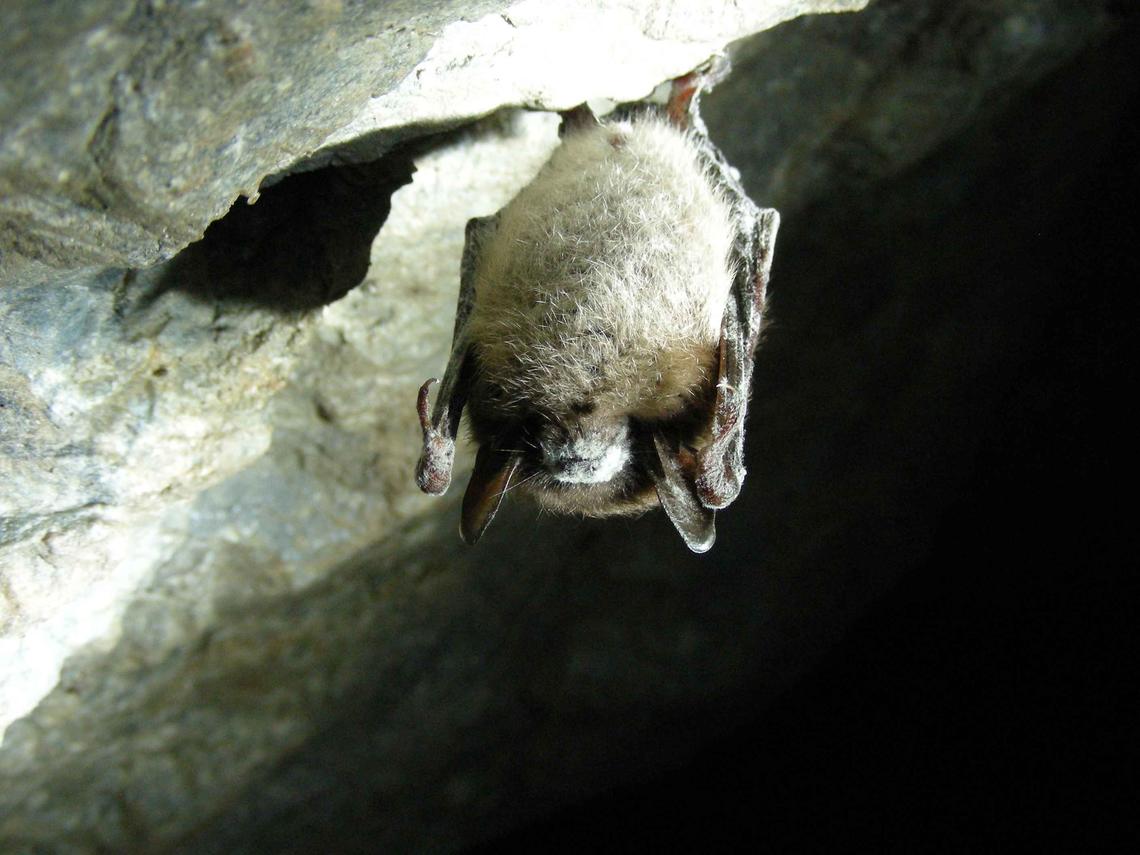Nov. 1, 2016
Alberta bats threatened as deadly white-nose syndrome appears to be moving westward

A disease that is devastating bat populations in the Eastern United States and Canada may be spreading to Alberta and British Columbia.
White-nose syndrome is believed to be caused by Pseudogymnoascus destructans, a fungus that colonizes the skin of bats during hibernation. It’s named for the white fuzz that develops on the muzzle and wings of infected animals.
“The irritation caused by the fungus disturbs hibernation and results in the bats using up fat stores before food is available in spring,” says Sam Sharpe, anatomic pathologist with the University of Calgary Faculty of Veterinary Medicine (UCVM). “Eventually the bats starve to death.”
Disease claims about six million bats in North America so far
The disease, first detected in New York State in 2006, steadily spread to the Atlantic provinces, Quebec and Ontario. Bat populations are being decimated. To date, white-nose syndrome is associated with the death of some six million bats in North America.
This spring, the first case in western North America was found in a bat in Washington state. Sharpe says that means the pathogen defied predictions and apparently jumped right across the continent. “If the disease takes root and spreads as it has done in the East, this now places bats in Alberta and B.C. in direct risk of similar devastation.”
Not much is known about how the disease spreads. It may be transferred by bat-to-bat contact, and, while it’s not a human health risk, the disease may be carried by people, such as climbers and cavers, from one hibernation site to another.

A bat with white-nose syndrome being examined under UV lighting.
Jordi Segers, CWHC
Important contributors to ecosystem
So, why should we care about bats?
“Standing up for bats is a tricky PR exercise as they have been characterized as either blood-sucking vampires or winged rodents that carry rabies,” says Sharpe.
But bats play a vital role in a healthy ecosystem, eating insects that are crop pests and potential vectors for disease in people. An economic analysis found the insect population management that bats provide farmers saves billions of dollars a year in the U.S. And recent studies show big increases in pesticides and fungicides on crops in areas where the disease is present.
“While the effect on crop pests and insect disease vectors is clear, the full consequences of a catastrophic decline in bat numbers will only really be known if it is allowed to occur,” says Sharpe.
Taking action — surveillance, testing and research
The Canadian Wildlife Health Co-operative (CWHC) runs a national surveillance program for white-nose syndrome, and supports a number of research projects into the disease. It also facilitates co-operation between a wide variety of federal and provincial agencies and researchers on a national scale.
“This co-operation is essential to combat an epidemic that has crossed provincial and national borders,” says Sharpe.
Bats submitted by wildlife partners, including Parks Canada, provincial parks, and provincial Fish and Wildlife services, are tested at CWHC regional centres or at the Alberta Environment and Parks laboratory in Edmonton. The Alberta CWHC pathology service is located at UCVM’S Spy Hill campus in association with the Diagnostic Services Unit.

Hibernating bat with white fuzz around its muzzle, indicative of white-nose syndrome infection.
Watch and report abnormal bat behaviour
“When bats are in hibernation, we swab their wings, tail, nose, and ears to test for white-nose syndrome,” says Collin Letain, Alberta co-ordinating wildlife technician for CWHC. “We do this during hibernation as this is when bats are known to come into contact with the fungus.”
“I encourage the public to keep their eyes open for dead bats or abnormal bat behaviour such as flying during the day or during the winter when bats should be hibernating, as these should be investigated,” says Sharpe. “People should inform Fish and Wildlife or Parks Canada, who know how to handle bats safely. Bats can carry diseases such as rabies.”
The support UCVM gives to the CWHC in resources and expertise allows surveillance work to be carried out in Alberta and for data collected here to be added to that collected across Canada. UCVM works in partnership with the wildlife disease staff at Alberta Environment and Parks.
“With the disease potentially on the verge of becoming established in the West, this work is of vital importance,” says Sharpe.
